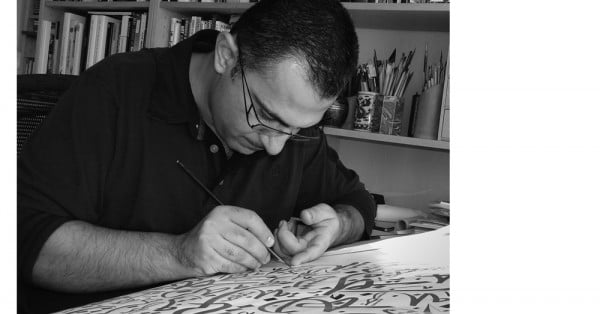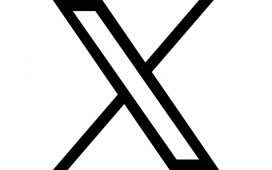
Celebrated Iraqi calligrapher Wissam Shawkat talks art, typography and its (mis)use by Middle East advertisers with Eleanor Dickinson
Basra in the mid-1980s was a city under siege, which for some meant there was a lot of time to kill. As bombs pounded the city at the height of the Iran-Iraq war, civilians fled their offices, shops and schools for the safety net of concrete shelters buried under the earth.
With little else to do but wait for the sirens to end, one 10-year-old boy began to practice what would become a passion for the rest of his life: the art of Arabic calligraphy. Thirty years later and now an award-winning calligrapher and artist, Wissam Shawkat sits in front of me in an office overlooking the Palm Jumeirah, Dubai, worlds away from his bomb-ridden childhood. But those early memories of learning calligraphy remain intact.
“The first time I saw Arabic calligraphy was when my art teacher at primary school wrote some letters on the blackboard,” he reminisces. “From that moment it was just something inside me; I loved the form and shapes. It became an obsession and I was a kid spending my time in shelters doing nothing, so my father bought me a calligraphy book. I just copied from that, practicing and learning. Then I began buying resources, a couple of books; there were not many at that time, but just enough for me to practice.”
Now, having perfected his own style blending traditional craftsmanship and modern aesthetics, Shawkat has a perfect vantage point from which to view calligraphy’s development in design and advertising.
“There are many calligraphers, but there are not many who are dealing with calligraphy, typography and Arabic design,” he explains. “For me, I am not just a traditional calligrapher because I love design. In the 14 years since I moved here, I have noticed that this is not very popular. When I worked in agencies, they thought any graphic designer could work with typography and calligraphy, but in reality they cannot. It’s specialised; in Latin, there are people who study typography. But when it comes to the Arabic side – such as in the world of Arabic fonts – there are very few. But it’s building up.
“When it comes to calligraphers who practise it as an art form, most of them do not care about design. That’s fine; they just do it as a traditional thing. For me, I kind of join both because I love design, I love art and plus I love calligraphy, so it happened like that.” He adds: “For me design is art – the media is different but the aesthetics are the same.”
However, Shawkat’s knowledge of the discipline has given him a keener eye when it comes to the incorrect – and sometimes downright poor – use of calligraphy and typography by some of the region’s biggest agencies and brands. And part of this comes from a lack of education in the field among the region’s emerging design talent, except, he admits, in Lebanon, where the study is taught at an earlier age. But elsewhere, these bad examples can be easily spotted by anyone with knowledge in the discipline.
“There are so many – I will call them bad designs – when it comes to logos,” he says. “When I worked with agencies, sometimes there would be a brand development and they would develop the Latin word and then want to create the same in Arabic. So because the creative designer or director was not Arab, they would ask someone to type the word for them in Arabic. They would then just look at the form and end up chopping off Latin letters to create the Arabic word. You can see many examples of this, which is completely wrong. You need to have understanding of the letters, the flow, the form. You might find a lot of famous logos that have terrible calligraphy in the logo itself. Sometimes a client will approach me and say, ‘oh we like the calligraphy in that brand and can we do something similar?’ And I end up telling them it is crap.”
Though a civil engineer on paper – “three years of study, wasted” – Shawkat’s relentless pursuit and practise of calligraphy, coupled with his love of art and visual design, helped him rise to the upper echelons of Baghdad’s flourishing art scene after leaving the army in 1996. But, anticipating trouble ahead, he took an exhibition in Sharjah to leave the country and start again in the United Arab Emirates months before the allied invasion of Iraq.
“Many branding agencies are run by non-Arabs and have Western heads so maybe they are not used to doing that. Some big agencies do – they hire me – but when it comes to big campaigns you still see the Western effect in the design and the ideas. When it comes to the culture, they use the stereotypes of the region.
“We have a beautiful heritage of Arabic calligraphy and I don’t see it being used by agencies. You don’t see a campaign based on Arabic typography or calligraphy. There’s big potential. But if you are not practising calligraphy, if you do not understand the rules, secrets and all this stuff, then there will be something missing.”
* Wissam Shawkat will be appearing at the ING Creative Festival, Dubai Design District, at 11.30am on April 30









